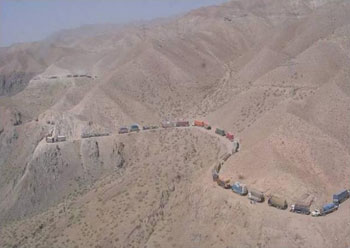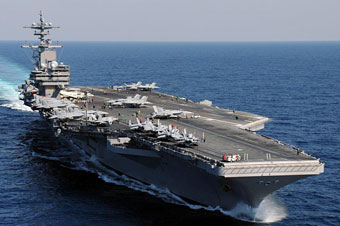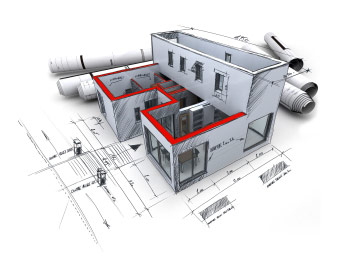DUSD Dorothy Robyn on DoD’s Evolving Energy Revolution
Dorothy Robyn, Ph.D. and Deputy Under Secretary of Defense (DUSD) Installations & Environment (I&E), is an accomplished economist, a creative thought leader and a results-oriented sustainability advocate. She’s responsible for streamlining Department of Defense (DoD) energy usage at 500 installations, both foreign and domestic, which includes 546,000 buildings. As such, Robyn spends a big part of her work day fast-tracking DoD’s energy revolution.
“Picture a pie chart representing DoD total energy consumption and one-quarter would be for facility energy, mostly electricity, consumed by our permanent military bases. Most is for electricity to power buildings; however, we also have 160,000 fleet vehicles – regular cars and trucks used on bases. Total 2009 Defense energy consumption represented about $13 billion. Roughly $4 billion was for facilities, and the rest was for operational energy or fuel,” explains Robyn. Compare 2009’s energy price tag to 2008, which totaled $30 billion thanks to sky-high oil prices, and it becomes clear why fluctuating energy prices present a Defense nightmare. This is why conservation, alternative and renewable energy have been, and continue to be, mission critical.

© iStockphoto.com/LilliDay
“We have three key energy arena goals we’re trying to meet. One is to reduce energy intensity – BTUs consumed per square foot – by 30 percent by 2015 and 37.5 percent by 2020, relative to a 2003 baseline. We were on track to meet our annual target – we reduced consumption by 10 percent – but, we didn’t make it. I think this occurred largely because DoD has an enormous amount of BRAC (Base Realignment and Closure) activity going on, which means we’re simultaneously operating in two different places in many locations and also because of war-related activity. But, I think our numbers will look better for 2010,” comments Robyn. She shares that although the energy intensity reduction goal is an ambitious one, it’s probably the single most important goal. In fact, it’s the number one high-performance goal DoD has when it comes to the Office of Management and Budget (OMB).
However, the Deputy Under Secretary hastens to add that “our targets do not apply to operational energy. It’s not responsible to say to warfighters, ‘You have to reduce your fuel usage.’ Most Federal agencies set targets for energy reduction and it’s a department-wide target. In the case of DoD, the target is limited to facilities – the world that I oversee. So for that one-quarter of the pie, our performance will determine whether we meet our goals.”
The second energy arena goal is to provide 25 percent of DoD energy from alternative and renewable sources by 2025. Each year’s percentage goal corresponds to that year. For instance, the 2015 goal is 15 percent renewable; the 2020 goal is 20 percent renewable. The third goal – one DoD set internally – is reduction of greenhouse gas (GHG) emissions. Robyn comments that “by 2020, we’re committed to reduce our Scope One and Scope Two GHG emissions by fully 34 percent relative to a 2008 baseline. That’s very ambitious, but I think if we make our other goals, we’ll make our GHG goal. Again, we imposed that upon ourselves and went beyond other targets. Although this is a DoD goal, it falls entirely on facilities to make this happen.”
Energy as a Mission-Critical Component
Robyn continues to add that DoD is “not primarily motivated by desire to comply with statutory targets. This is about improving the Defense Department’s ability to carry out its mission. We’re doing this because we think it will make us better warfighters. It’s compelling and easy to show this on the operational side. One look at a Khyber Pass fuel convoy makes it clear that this is just good business.
 Photo Credit: U.S. Army |
A supply convoy snakes its way through the mountains of Afghanistan. The danger faced by the Soldiers and civilians driving and guarding these convoys stresses the need for fuel saving technologies. |
The Deputy Under Secretary comments that mission critical activities, such as training and deployment, go on at all DoD installations. They also increasingly provide reach-back support for combat operations. Therefore, it’s important to make sure those activities are secure and not vulnerable to the grid. The more the Department can reduce energy demand, the better off it is. And, bringing renewables into the picture can increase energy security.
Robyn further explains that DoD “doesn’t want to be independent of commercial infrastructure. In fact, the trend has been to leverage, as much as we can, the commercial market in the interest of DoD needs. Historically, the Defense Department tended to have more of a ‘fortress’ mentality, but in the past 20 years, it has moved more and more toward privatization, such as family housing and utilities on military bases. More and more, where possible, we take advantage of the commercial market. We do, however, want to have back-up energy supply; we want to be able to operate critical activities if the grid goes down. Smart micro-grid technology becomes important in that context because it’s a way to prioritize and to maintain each installation’s ability to operate mission critical activities.”
Incentives for Intelligent Energy Use
The economist emerges in Robyn when she discusses “how incentives are not properly aligned; it’s one of the big hurdles we face. DoD is a command and control organization. That’s good in certain respects because if troops are told to do something, they’ll march off and work very hard to do it. But, one can’t rely on the usual kind of market incentives. An example of this is a commander who works diligently to reduce installation energy consumption and then doesn’t get to keep the savings beyond that year. The Air Force is trying to remedy this by having a competition in which commanders who do the best job of reducing energy consumption win a cash award. That award can then be plowed back into additional energy efficiencies or other things beneficial to their installation.”

U.S. Navy photo by Mass Communication Specialist 3rd Class Nicholas Hall
Robyn comments that the best energy program she’s familiar with on the operational side is a Navy one “that’s been around for awhile. If a ship captain lowers energy usage, he or she gets to keep half the savings. Unfortunately, there’s nothing service-wide similar to this because DoD hasn’t figured out how to deal with budget requirements. However, I’m talking with OMB, the Comptroller’s Office and the Services about how to institute similar shore-side facility incentive programs within a win-win set of priorities.
“With family energy savings incentive programs we have a different set of challenges. Historically, families have received a base housing allowance, which includes rent and utilities. Economist-types, like myself, want families to face their utility costs, which will not only reduce energy use, but also create opportunities for savings. However, the military is concerned with families suddenly having to pay for something that they traditionally haven’t had to. So, they’re moving toward this change in a gradual way. The Marines and Army have a program where they calculate average energy use for a family of a certain size. If energy usage is more than 20 percent above that average, the family pays a penalty. If it’s below the average, it gets money back. This type incentive program begins to move the military in the right direction.”
Better Metrics for Better Performance
Robyn points out, however, that family housing is a fairly small energy consumer comparatively speaking. Industrial facilities and those involving refrigeration are the largest energy users, such as commissaries, hospitals, depots, aircraft repair and maintenance facilities and data centers.
According to the Deputy Under Secretary, DoD doesn’t “meter nearly enough. As a result, we don’t have good data on our energy consumption. The Navy has done a far better job of metering than other Services. But, we have a long way to go. It’s absolutely critical because one of the pillars in improving energy performance is collecting data. That will allow us to set better metrics against which to measure our performance.”
Robyn maintains that DoD buildings tend to be less energy efficient compared to comparable commercial facilities. Therefore, tracking performance over time, collecting data and beginning to manage more effectively are mandatory for improved DoD energy efficiency. In addition, improved metering and better metrics need to be coupled with a Department-wide energy information management system, which is currently lacking. The Services have systems, but DoD has no Department-wide system or network to draw data from.

© iStockphoto.com/Ichabod
“There’s metering guidance out there now,” explains Robyn, “but it’s pretty loose. It basically says, ‘Meters and sub-meters are required for all appropriate facilities’ – appropriate facilities being those for which the Service has determined metering would be cost-effective and practical. The Services have interpreted that statement in very different ways. The Dept. of the Navy has taken that guidance and metered 26,000 buildings, thus capturing 95 percent of their facilities. Conversely, the Army has said 29,000 sq. ft. is the threshold. That’s a very large building; that threshold captures a relatively small fraction of the Army’s total facilities.”
Robyn is currently looking at options to inform policy on this issue. She’s deciding how low the square footage should go relative to cost, maintenance, improvement and performance. Beyond these issues, she’s considering how meters can provide information on problems that may otherwise “go unchecked.” Although the normal argument is to meter larger buildings in order to capture the majority of energy usage, Robyn is leaning toward monitoring smaller buildings as well. Small buildings – the DoD has 300,000 of them – account for a very large share of the total Department’s facility footprint of 546,000 buildings.
MILCON as a Transformative Agent
“The big vehicle for improving facility energy efficiency is the MILCON (military construction) budget. Increasingly, as DoD becomes more serious and aggressive about energy transformation, the MILCON budget, and that includes the O&M (operations and maintenance) budget, has to be the big vehicle for change. Energy efficiency is not just the low-hanging fruit; it’s the fruit lying on the ground, which is all about retrofitting – more efficient boilers, HVAC systems and windows, daylighting and so forth. It’s all that not very sexy stuff, but that’s the name of the game. New construction is very important, but it won’t get us where we need to go because we’re not putting up enough new buildings. Most of our buildings are existing buildings.
“Military construction, rather than any narrow program designated for energy efficiency, is how we’re going to get from here to there. And, to some extent, that also means rethinking how DoD does military construction. There’s been a tendency equivalent to saying, ‘OK, I want to buy a SUV, now let me figure out how to make it energy efficient,’ rather than thinking what sort of vehicle to buy to meet my needs. We need to rethink the basic design of DoD buildings. We know from work done by the National Academy of Sciences and other organizations that we can get fairly significant energy efficiency improvements. But, to get those kinds of improvements, we need to approach new construction in a very integrated way. The building operator, architect and engineer need to be thinking about energy as an integral part of the design from day one,” comments Robyn.

© iStockphoto.com/Franck-Boston
The Deputy Under Secretary understands how large organizations work – the many reasons why people don’t want to change. She explains that DoD “can make decent improvements with existing technology and existing business practices, but it’s new technology that offers really dramatic improvements in energy efficiency. But, huge impediments exist to commercialization and deployment of that technology. One of them is architecture and engineering firms. They face potential liability if there’s an operational failure associated with new technology, but they don’t see the upside. They don’t get rewarded, so they’re incentivized to be risk-averse. Most people are. And, we also suffer from split-incentives – the people making decisions about what goes into a building in terms of energy efficiency aren’t the ones paying utility bills.
“In DoD, split incentives also take the form of savings down the road in O&M budgets, so there’s a color of money issue for the Federal government – a capital expenditure versus an O&M savings. These can be very high transaction costs because we don’t have enough data and evidence on these decisions. So, for all these reasons, it’s notoriously difficult to get new technology, especially new energy technology, into the building industry. It’s a very fragmented industry – low R&D. Recognizing this problem, Wal-Mart has created a test-bed for emerging technologies useful for big-box stores. They’ve done a really good job on this. And, because Wal-Mart is vertically integrated, they don’t have a split-incentive problem. They behave intelligently; they test technology and deploy what works in a centralized way,” remarks Robyn.
DoD Installations as Technology Test-Beds
DoD is one of the few organizations, like Wal-Mart, large enough to create energy technology test-beds for its self-interest, which will, simultaneously, speed deployment and commercialization for national benefit. It’s a test and evaluation function with a twist because of its capability to begin a US energy revolution – and it’s already begun thanks to DoD’s keen understanding that national security cannot be separated from energy security.
Robyn elaborates on her team’s ingenious role: “Other organizations are doing energy technology R&D, but then it goes into the ‘valley of death,’ stops there and is very slow to get out. We’re uniquely positioned to play this test-bed role. As such, we created a program with American Reinvestment and Recovery Act (ARRA) money in 2009 – $20 million – and then kept it going with other funding. It’s now a $30 million per year program.
“Our test-beds for innovative energy technologies are doing work in three different areas: energy component technologies, smart micro-grid and systems-approaches. In particular, the latter involves the concept of continuous building commissioning via a combination of wireless monitors and modeling technology, which incorporates data on outside weather. This process allows for fairly dramatic improvements. United Technologies Research Center is doing cutting-edge work, and they’re our partner on several of these projects. It’s a very high-tech system using a building envelope that is continually self-monitoring and that adjusts accordingly in real-time – similar to the human body. This is new energy technology that we’re test-bedding that is not commercially available yet. In some cases, we’re working with existing technology; in some cases, we’re working with new technology; and, in other cases, it’s a mix of both.”

©iStockphoto.com/CelesteQuest
One new technology Robyn’s team is test-bedding is Building Integrated Photovoltaic (BIPV) Roofs for Sustainability and Energy Efficiency. This has tremendous military application because DoD does an enormous amount of roof replacement. The Under Secretary notes that with new technology “timing is everything.” In other words, BIPV would be most beneficial when roof replacement is imminent. Ironically, DoD doesn’t currently utilize BIPV because US Army Corps of Engineers (USACE) and Naval Facilities Engineering Command (NAVFAC) don’t have performance data. It’s not included in the “Roofer” software program both organizations use. In an effort to correct this, Robyn’s team is testing BIPV at Luke Air Force Base. The data is being systematically collected by NAVFAC and will be included in the Roofer software program when complete. This will allow DoD to utilize BIPV.
Robyn’s enthusiasm is contagious as she comments: “I’ve become a complete fanatic about these test-bed programs. It’s only a $30 million program compared to MILCON’s $23 billion budget, but, to me, this is how we get from here to there. This is what DoD is all about. In the late 1800s, Eli Whitney came to the Defense Department with technology for interchangeable machine-made parts for musket production. He developed the technology for the cotton gin and DoD took it and used it for musket production. Normally, DoD does both the R&D and the customer part, which is why the Department has been so successful. We’ve been the R&D performer and the customer, making ours a hand-in-glove relationship. In the energy area, for the most part, we won’t be doing R&D, but we can be a really powerful customer.”
Sustainability as a Bottom-Line Driver
The Deputy Under Secretary continues by saying: “I have to emphasize to people in the Pentagon that this is in our self-interest. Yes, it can have huge spill-over benefits for the nation, but it’s definitely in our self-interest. That just makes the business case stronger, and that’s why I talk about Wal-Mart because they’ve figured it out.
“Sustainability is broader reaching than just energy. DoD has been increasingly focused on sustainability in environmental issues for a long time. But, we’re going through a similar transformation with respect to energy. What really grabbed peoples’ attention were the convoys – the problem with getting fuel to theatre. That’s driving behavior. The Marines went to Helmand Province in October 2010 carrying solar equipment that folds up into a suitcase and tent shields and solar power communications equipment. They’re doing amazing things with respect to expeditionary energy. And on the facilities side, for different reasons, similar things are happening. DoD is a big organization and it will take awhile, but once the policies are in place, it will have a lot of momentum.
“Many young people in the military get it, and there’s commitment at the top. It’s not just conversation; it’s here to stay,” concludes Robyn, which is why this is the next evolution in DoD’s energy revolution




























